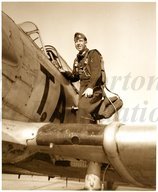
|

|
|
|
|
"Stan," as he was called, was born in Murray, Utah, a suburb of Salt Lake City, to James C. and Dora Johnson. James was a heavy machine equipment operator who drove bulldozers and road graders while working for Salt Lake County, and served as a volunteer county fireman. Stan's mother died after a year-long illness when he was in the fourth grade. Two years later his father married a woman Stan recalls as Stella. She brought one son into the marriage. The couple had two children. Pearl Harbor was bombed when he was in the seventh grade at Murray Junior High School. While his father worked at Remington Arms, producing .50 caliber machine gun bullets, Stan cut sugar beets, set pins at a bowling alley, ushered at a movie theater, and worked at Alta Airpark refueling airplanes. He soloed soon after finishing Murray High School in 1947. Stan enrolled at Utah State University, and earned his Aircraft and Engine Mechanics license. By the time he enlisted in the U. S. Air force in September of 1950, he already had 100 hours of flying time. Stan was sent to Lackland Air force Base in San Antonio, then to Barksdale Air For Base for basic training. He worked in the orderly room as a typist at Barksdale, and then at Forbes Air Force Base in Topeka, Kansas. He was then sent to Greenville Air Force Base in Mississippi to T-6 training, and then transferred to Enid, Oklahoma, where he flew B-25s and earned his wings on September 13, 1952. Ordered to Japan, he flew night missions of four to six hours over North Korea. He bombed bridges, military installations, air fields, and roads. He flew 100 missions from March to July of 1953. In Japan, he noticed civilians reluctant to discuss World War II. "The Japanese hated the B-29," he says, of the plane that wreaked so much damage in the country. Back home in the States he was assigned to the 95th Bomb Wing at Biggs Air Force Base in El Paso, where he flew the new B-36. In January of 1956 Stan married Shirley Ann McGee. They had four children. On November 12, 1967, he married Louise Walker, who had a son by a previous marriage. In all, he has five children, fourteen grandchildren, and one great grandchild. In late summer of 1959 he transferred to Eglin Air Force Base in Florida, a Strategic Air Command base, where he flew the B-52G model, a much faster plane than the B-36. While there, he flew the first camouflaged B-52. During the Cuban Missile Crisis, Stan flew between the Mediterranean and Eglin in airborne alerts. Earning his education degree from the University of Omaha, he trained at England Air Force Base in Alexandria, Virginia, in the C-123. Next, in Little Rock, he trained in the C-130, an aircraft he calls "the workhorse of all aircraft in the Vietnam War." Stan flew two combat tours in Vietnam, one consisting of 125 B-52 missions, and another in the C-130, taking supplies from Saigon "all over Vietnam and Thailand." Stan's wing was selected to retrieve prisoners of war from North Vietnam after the war ended. "There were a lot of tears. We were the first Americans they'd seen in years," he says of the POWs. Stan retired on August 1, 1973. He flew corporate planes, then took over as superintendent of operations of the regional airport. Meanwhile, he used the GI Bill to learn to fly helicopters. Stan retired on April 1, 1995. |


